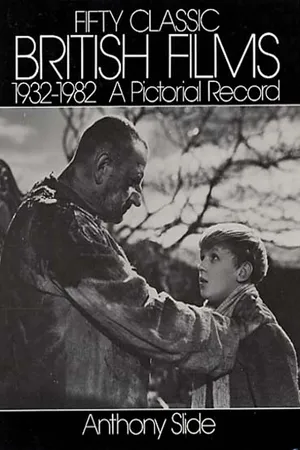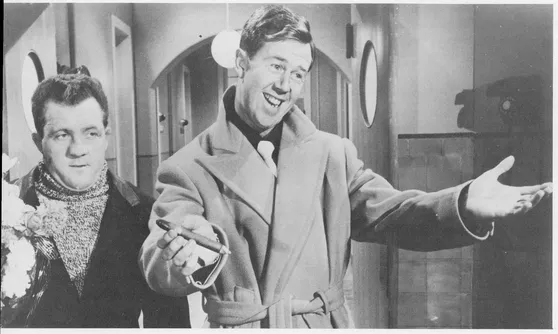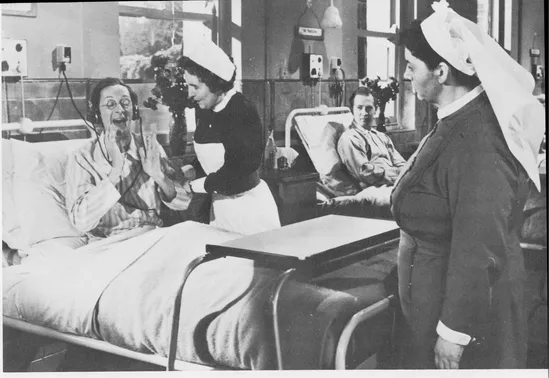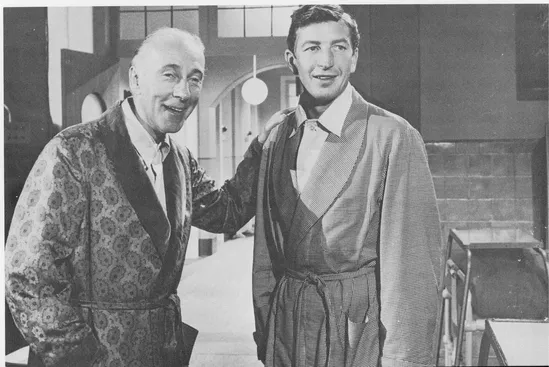
- 160 pages
- English
- ePUB (mobile friendly)
- Available on iOS & Android
eBook - ePub
About this book
200 striking photographs, in-depth commentaries, plot synposes, contemporary reviews, and more — about 50 British classics from yesterday and today. Preface. Text. Alphabetical list of films. Bibliography.
Frequently asked questions
Yes, you can cancel anytime from the Subscription tab in your account settings on the Perlego website. Your subscription will stay active until the end of your current billing period. Learn how to cancel your subscription.
No, books cannot be downloaded as external files, such as PDFs, for use outside of Perlego. However, you can download books within the Perlego app for offline reading on mobile or tablet. Learn more here.
Perlego offers two plans: Essential and Complete
- Essential is ideal for learners and professionals who enjoy exploring a wide range of subjects. Access the Essential Library with 800,000+ trusted titles and best-sellers across business, personal growth, and the humanities. Includes unlimited reading time and Standard Read Aloud voice.
- Complete: Perfect for advanced learners and researchers needing full, unrestricted access. Unlock 1.4M+ books across hundreds of subjects, including academic and specialized titles. The Complete Plan also includes advanced features like Premium Read Aloud and Research Assistant.
We are an online textbook subscription service, where you can get access to an entire online library for less than the price of a single book per month. With over 1 million books across 1000+ topics, we’ve got you covered! Learn more here.
Look out for the read-aloud symbol on your next book to see if you can listen to it. The read-aloud tool reads text aloud for you, highlighting the text as it is being read. You can pause it, speed it up and slow it down. Learn more here.
Yes! You can use the Perlego app on both iOS or Android devices to read anytime, anywhere — even offline. Perfect for commutes or when you’re on the go.
Please note we cannot support devices running on iOS 13 and Android 7 or earlier. Learn more about using the app.
Please note we cannot support devices running on iOS 13 and Android 7 or earlier. Learn more about using the app.
Yes, you can access Fifty Classic British Films, 1932-1982 by Anthony Slide in PDF and/or ePUB format, as well as other popular books in Media & Performing Arts & British History. We have over one million books available in our catalogue for you to explore.
Information
Subtopic
British HistoryCARRY ON NURSE
Produced by Peter Rogers for Nat Cohen and Stuart Levy. Released 1959, Anglo Amalgamated Film Distributors (U.K.); 1960, Grosvenor Films (U.S.). 86 minutes. Black and white.
Director: Gerald Thomas. Screenplay: Norman Hudis. Cinematography: Reg Wyer. Art Direction: Alex Vetchinsky. Music: Bruce Montgomery. Film Editing: John Shirley.
CAST:
Patients
Kenneth Connor (Bernie Bishop); Kenneth Williams (Oliver Reckitt); Charles Hawtrey (Hinton); Terence Longdon (Ted York); Bill Owen (Percy Hickson); Leslie Phillips (Jack Bell); Cyril Chamberlain (Bert Able); Brian Oulton (Henry Bray); Wilfrid Hyde-White (The Colonel); Sidney James (Gladstone Screwer); Ed Devereaux (Alec Lawrence); Frank Forsyth (John Gray); John Mathews (Tom Mayhew); Graham Stewart (George Field); David Williams (Andrew Newman); Patrick Durkin (Jackson).
Visitors
Jill Ireland (Jill Thompson); Susan Shaw (Mrs. Janie Bishop); Irene Handl (Mrs. Marge Hickson); June Whitfield (Meg); Marianne Stone (Mrs. Alice Able); Hilda Fenemore (Mrs. Rhoda Bray); Martin Boddey (Perkins); Michael Medwin (Ginger); Norman Rossington (Norm).
Hospital Staff
Hattie Jacques (Matron); Joan Hickson (Sister); Shirley Eaton (Nurse Dorothy Denton); Susan Stephen (Nurse Georgie Axwell); Joan Sims (Nurse Stella Dawson); Susan Beaumont (Nurse Frances James); Ann Firbank (Nurse Helen Lloyd); Rosalind Knight (Nurse Nightie Nightingale); Marita Stanton (Nurse Rose Harper); Florence Knight (Nurse Willing); Harry Locke (Mick); Leigh Madison (Miss Winn); Stephanie Schiller (new nurse); Christine Ozanne (fat maid); Shane Cordell (wow-of-a-nurse); John Van Eyssen (Stephens); John Horsley (anaesthetist); Lucy Griffiths (civilian saleswoman); Anthony Sagar (first ambulance man); Fred Griffiths (second ambulance man); Charles Stanley (porter).
SYNOPSIS: An episodic, comedic study of life in the men’s wing of a large public hospital, where everyone is ruled by the stern and forbidding Matron, and the patients include a boxer with a broken wrist, a building worker with a broken leg, a prissy little man, a bookworm, and a Colonel who, from his private room, directs the nurses to place bets for him. Also among the patients is a newspaper reporter, Ted York, gathering material for an article on hospital life, who falls in love with the prettiest of the nurses, Dorothy Denton.
COMMENTARY: British cinema in the fifties and sixties offered a variety of comedy series, not all of which look fresh today. With Trouble in Store (1953), Up in the World (1956), The Square Peg (1958), and Follow a Star (1959), Norman Wisdom (b. 1920) endeared himself to the public as the British film industry’s answer to Charlie Chaplin, blending slapstick and sentiment in uneven doses, and crooning his theme song, “Don’t Laugh at Me ‘Cause I’m a Fool.” At the same time, handsome juvenile Dirk Bogarde (b. 1920) provided lighter, very innocuous humor with the “Doctor” series, based on the novels by Richard Gordon. Although successful in their day, Doctor in the House (1954), Doctor at Sea (1955), and Doctor in Distress (1963) now seem sadly dated and lackluster.
The one comedy series begun in the fifties which has remained vibrant (and vulgar), and which has never died, despite the demise of many of its regular players, is the “Carry On” series. All produced by Peter Rogers and directed by Gerald Thomas, the “Carry On” films continue the tradition of British music-hall humor; they have all the knockabout fun of the Crazy Gang shows, all the vulgarity of a Max Miller or Max Wall monologue. Whether verbal or visual, the humor is unfailingly vulgar. Even the titles smack of vulgarity, such as Carry On Cruising (1962), Carry On Camping (1968), Carry On Dick (1974), Carry On Behind (1975), and Carry On at Your Convenience (1971). (“Convenience” is the British name for a public lavatory.)
In The Carry-On Book by Kenneth Eastaugh, series regular Jim Dale explained the humor: “If on screen you see the front of a home and somebody opens a door and there’s a field behind, that’s American humor. If, when the door is opened, there’s a field with a lavatory in it, that’s French humor. If there’s a field with a lavatory and somebody sat on it, using it, that’s a ‘Carry On’ film.”
The hospital setting of Carry On Nurse provides endless opportunities for gags in this episodic feature—toilet paper becomes streamers, pubic hair is shaved with gusto, suppositories inserted with glee. One classic gag involves the Colonel, whose constant demands on the nurses drive them to seek revenge. They tell the Colonel that they must take his temperature prior to his release, and although the Colonel’s posterior is never seen, obviously there is a substitution for the anal thermometer. As the nurses prepare to photograph their unsuspecting victim, Matron enters and upon demanding what is going on is told by the Colonel, “Surely you’ve seen a temperature taken like this before.” “Oh, yes, Colonel, many times,” replies Matron, “but never with a daffodil.” The medical profession provided the “Carry On” team with two further features, Carry On Doctor and Carry On Again Doctor.
Carry On Nurse features many of the regulars of the series: Kenneth Connor, Kenneth Williams, Charles Hawtrey, Hattie Jacques, and Joan Sims. Other series regulars include Sidney James, Barbara Windsor, Peter Butterworth, Terry Scott, Jack Douglas, and Bernard Bresslaw. The music, interestingly, was composed by Bruce Montgomery, better known to readers of mystery novels as Edmund Crispin.
The first “Carry On” feature was Carry On Sergeant, released in 1958. (Twenty years later, there would be a “Carry On” compilation, That’s Carry On.) Carry On Nurse, however, was the first of the series to be released in the United States. No New York exhibitor would initially book the film, and so it opened, without reviews, in Los Angeles, running there for twenty-seven weeks. When reviews did appear, they were lukewarm. Florence Fletcher in Cue (September 10, 1960) was probably the most enthusiastic: “The witticisms in this British hospital men’s ward romp are right out of old-time vaudeville and the acting is broad enough to make sure that everyone gets the anatomical point.” Carry On Nurse became something of a cult favorite and indirectly paved the way for the American successes of the Monty Python troupe and Benny Hill.

Hospital visitors include Norm (Norman Rossington, left) and Ginger (Michael Medwin); on screen from the mid-forties, Medwin became a leading British producer as co-owner of Memorial Productions.
The love interest in Carry On Nurse is provided by Terence Longdon and Shirley Eaton as Ted York and Nurse Denton.


Matron (Hattie Jacques) confronts patient (Charles Hawtrey).
Wilfrid Hyde-White as the Colonel and Terence Longdon as Ted York.

SATLIRDAY NIGHT AND SUNDAY MORNING
Produced by Harry Saltzman and Tony Richardson for Woodfall Films. Released 1960, British Lion/Bryanston (U.K.); 1961, Continental Distributing (U.S.). 89 minutes. Black and white.
Director: Karel Reisz. Screenplay: Alan Sillitoe (based on his novel). Cinematography: Freddie Francis. Art Direction: Ted Marshall. Music: Johnny Dankworth. Film Editing: Seth Holt.
CAST: Albert Finney (Arthur); Shirley Anne Field (Doreen); Rachel Roberts (Brenda); Hylda Baker (Aunt Ad...
Table of contents
- DOVER BOOKS ON CINEMA AND THE STAGE
- Title Page
- Copyright Page
- PREFACE
- Table of Contents
- ROME EXPRESS
- THE GOOD COMPANIONS
- I WAS A SPY
- THE PRIVATE LIFE OF HENRY VIII
- NELL GWYN
- SING AS WE GO
- THE SCARLET PIMPERNEL
- WINGS OF THE MORNING
- YOUNG AND INNOCENT (The Girl Was Young)
- ST. MARTIN’S LANE (Sidewalks of London)
- THE LADY VANISHES
- PYGMALION
- LET GEORGE DO IT
- LOVE ON THE DOLE
- IN WHICH WE SERVE
- THE LIFE AND DEATH OF COLONEL BLIMP
- ON APPROVAL
- HENRY V
- DEAD OF NIGHT
- BRIEF ENCOUNTER
- A MATTER OF LIFE AND DEATH
- GREAT EXPECTATIONS
- ODD MAN OUT
- MR. PERRIN AND MR. TRAILL
- KIND HEARTS AND CORONETS
- THE THIRD MAN
- THE MAGIC BOX
- GENEVIEVE
- THE BELLES OF ST. TRINIAN’S
- THE LADYKILLERS
- THE SMALLEST SHOW ON EARTH
- ROOM AT THE TOP
- CARRY ON NURSE
- SATLIRDAY NIGHT AND SUNDAY MORNING
- THE INNOCENTS
- THE LONELINESS OF THE LONG DISTANCE RUNNER
- THIS SPORTING LIFE
- BILLY LIAR
- THE SERVANT
- A HARD DAY’S NIGHT
- REPULSION
- A MAN FOR ALL SEASONS
- IF...
- THE PRIME OF MISS JEAN BRODIE
- WOMEN IN LOVE
- THE RAILWAY CHILDREN
- THE GO-BETWEEN
- BARRY LYNDON
- CHARIOTS OF FIRE
- GANDHI
- SELECTED BIBLIOGRAPHY
- ALPHABETICAL LIST OF FILMS
- FIFTY CLASSIC BRITISH FILMS 1932-1982 A Pictorial Record Anthony Slide